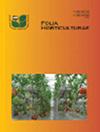食用菌废弃物制备育苗基质及应用研究
IF 1.8
4区 农林科学
Q2 HORTICULTURE
引用次数: 0
摘要
摘要为了提高蘑菇渣废弃物资源的利用率,寻找一种可替代的泥炭基质材料,研究了10种不同配方基质和3种市售基质的理化性质。此外,还探讨了这些物理化学性质对底物的相关性和影响。以油菜为原料进行盆栽试验。chinensis Makino var. communis Tsen et Lee(白菜)、Brassica chinensis L.(小白菜)、Cucumis sativus L.(黄瓜)和Cucurbita moschata Duch。ex-Poiret(南瓜)。结果表明,基质受持水孔隙度、通气性孔隙度、气水比、总孔隙度、pH、电导率(EC)、有效磷(AP)和有效钾(AK)的影响最为显著。随机森林(RFF)模型表明,pH和TN对白菜株高和茎粗的影响最大。pH、持水孔隙度和总孔隙度对株高、茎粗和幼苗活力指数的影响最为显著。有机磷和空气水比对黄瓜的根长和根冠比影响较大,而有机磷、空气水比和有机磷对南瓜的茎粗、根长和幼苗活力指数影响最大。盆栽试验期间4种蔬菜的生物学特性表明,10种基质中添加珍珠岩和蛭石的总体效果优于碱性组。其中,T2(蘑菇渣:锯末:催化剂:蛭石= 8:2:5:5)效果最好,可作为泥炭苗的替代基质。本文章由计算机程序翻译,如有差异,请以英文原文为准。
Research on preparing seedling substrates using edible mushroom waste and application
ABSTRACT To improve the utilisation of mushroom residue waste resources and identify a replaceable matrix material for peat, 10 different formula substrates and three commercially available substrates were examined to determine their physiochemical properties. Furthermore, the correlation and influence of these physicochemical properties on the substrates were explored. Pot experiments were conducted using Brassica campestris L. ssp. chinensis Makino var. communis Tsen et Lee (cabbage), Brassica chinensis L. (pakchoi), Cucumis sativus L. (cucumber), and Cucurbita moschata Duch. ex-Poiret (pumpkin). The results showed that the matrix was most significantly affected by water-holding porosity, aeration porosity, air-water ratio, total porosity, pH, electrical conductivity (EC), available phosphorous (AP), and available potassium (AK). The random forest (RFF) model indicated that pH and total nitrogen (TN) had the strongest influence on the plant height and stem diameter of the cabbage. Moreover, pH, water-holding porosity, and total porosity most significantly influenced the plant height, stem diameter, and seedling vigour index. AP and air-water ratio substantially affected the root length and root-to-crown ratio of the cucumbers, while EC, air-water ratio, and AP influenced the stem diameter, root length, and seedling vigour index of the pumpkin most. The biological characteristics of the four vegetables during the pot experiment indicated that the overall effect of the 10 substrates supplemented with perlite and vermiculite was better than in the basic group. Of these, T2 (mushroom waste: sawdust: catalyst: vermiculite = 8:2:5:5) displayed the best result and could be used as an alternative for peat seedling.
求助全文
通过发布文献求助,成功后即可免费获取论文全文。
去求助
来源期刊

Folia Horticulturae
Agricultural and Biological Sciences-Horticulture
CiteScore
3.40
自引率
0.00%
发文量
13
审稿时长
16 weeks
期刊介绍:
Folia Horticulturae is an international, scientific journal published in English. It covers a broad research spectrum of aspects related to horticultural science that are of interest to a wide scientific community and have an impact on progress in both basic and applied research carried out with the use of horticultural crops and their products. The journal’s aim is to disseminate recent findings and serve as a forum for presenting views as well as for discussing important problems and prospects of modern horticulture, particularly in relation to sustainable production of high yield and quality of horticultural products, including their impact on human health.
 求助内容:
求助内容: 应助结果提醒方式:
应助结果提醒方式:


